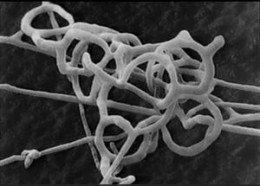 | ||
Representative species Arthrobotrys oligospora, Arthrobotrys dactyloides | ||
Carnivorous fungi or predaceous fungi are fungi that derive some or most of their nutrients from trapping and eating microscopic or other minute animals. More than 200 species have been described, belonging to the phyla Ascomycota, Mucoromycotina, and Basidiomycota. They usually live in soil and many species trap or stun nematodes (nematophagous fungus), while others attack amoebae or collembola.
Fungi that grow on the epidermis, hair, skin, nails, scales or feathers of living or dead animals are considered to be dermatophytes rather than carnivores. Similarly fungi in orifices and the digestive tract of animals are not carnivorous, and neither are internal pathogens. Neither are insect pathogens that stun and colonize insects normally labelled carnivorous if the fungal thallus is mainly in the insect as does Cordyceps, or if it clings to the insect like the Laboulbeniales.
Two basic trapping mechanisms have been observed in carnivorous fungi that are predatory on nematodes:
Sequencing of ribosomal DNA has shown that these trap types occur in separate fungus lineages, an example of convergent evolution.
